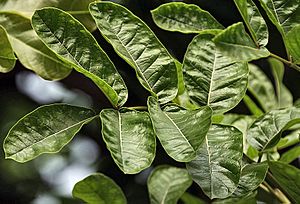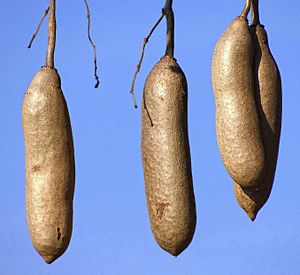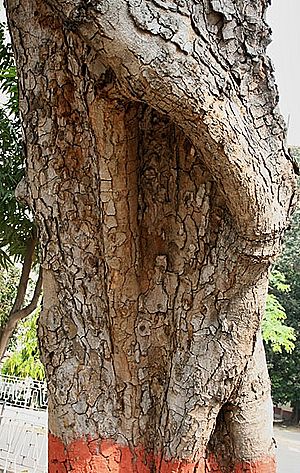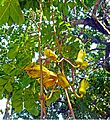Kigelia facts for kids
Quick facts for kids Kigelia |
|
|---|---|
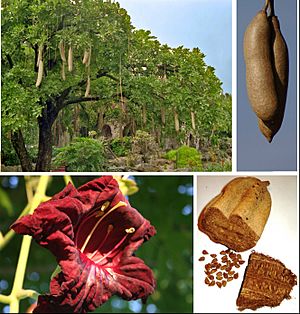 |
|
| K. africana habit, fruit, flower and seeds | |
| Scientific classification | |
| Genus: |
Kigelia
|
| Species: |
africana
|
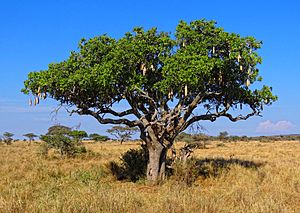
Kigelia is a group of flowering plants. It belongs to the plant family called Bignoniaceae. There is only one type of plant in this group, which is Kigelia africana. This amazing tree grows all over tropical Africa. It is often called the sausage tree because of its very unusual fruit. The fruit can grow up to 60 cm (2 feet) long. It can also weigh around 7 kg (15 pounds). It really does look like a big sausage hanging from the tree!
Contents
What's in a Name?
The name Kigelia comes from an African language. People in Mozambique called it kigeli-keia. The common names, like "sausage tree" and "cucumber tree," describe its long, sausage-shaped fruit. In Afrikaans, its name worsboom also means sausage tree. Its name in Arabic means "the father of kit-bags," which might refer to the fruit's shape.
About the Sausage Tree
The sausage tree can grow very tall. It can reach up to 20 m (66 feet) high. It usually has branches that spread out wide. The bark is smooth and grey when the tree is young. As the tree gets older, the bark starts to peel. The wood inside is light brown or yellowish. It doesn't usually crack.
Leaves and How They Grow
The tree's leaves stay green all year if there is enough rain. But if there is a long dry season, the tree will lose its leaves. The leaves grow in pairs or in groups of three. Each leaf is quite long, about 30 to 51 cm (12 to 20 inches). They have six to ten smaller oval-shaped leaflets. These leaflets can be up to 20 cm (8 inches) long.
Beautiful Flowers
The flowers of the sausage tree are very special. They hang down from the branches on long, flexible stems. These stems can be very long, sometimes up to 7.5 m (25 ft)! The flowers grow in clusters. They are shaped like bells, similar to the African tulip tree's flowers. But they are darker and more waxy. They can be orange, maroon, or purplish-green. Each flower is about 10 cm (4 inches) wide. They don't hang straight down but stick out sideways.
Unique Fruit
The fruit of the sausage tree is a very large, woody berry. It can be 30 to 99 cm (12 to 39 inches) long. It can also be up to 18 cm (7 inches) wide. Some have even been reported to be 20 cm (8 inches) wide! These heavy fruits usually weigh between 5 and 10 kg (11 and 22 pounds). They hang from those long, rope-like stems. Inside the fruit, there is a lot of tough, stringy pulp. This pulp contains many seeds.
Who Eats the Sausage Tree?
The flowers of the sausage tree attract some birds. The strong stems of the flowers are perfect for birds to hold onto. The flowers smell strongest at night. This suggests that bats help to pollinate them. Bats visit the flowers to get pollen and nectar. But the flowers also stay open during the day. Many insects visit them then, especially large ones like carpenter bees.
The fruit is a food source for several mammals. These include baboons, bushpigs, savannah elephants, giraffes, hippopotamuses, monkeys, and porcupines. The seeds from the fruit are spread when these animals poop. Brown parrots and brown-headed parrots also eat the seeds. Elephants and greater kudu eat the tree's leaves. Even cockatoos in Australia love the trees planted there.
How People Use the Sausage Tree
The fresh fruit of the sausage tree is not safe for humans to eat. It can make you sick. But people prepare the fruit in different ways to make it safe. They might dry it, roast it, or ferment it. In Botswana, the wood from the tree is used to make makoros (canoes). It's also used for yokes and oars.
Parts of the sausage tree are used in skincare. Extracts from the bark, flowers, and fruit are found in many products. This is because they have things that help fight damage and swelling in the skin.
The hard outer shell of the fruit can be used too. People can hollow it out and clean it. Then it becomes a useful container.
The tree is also planted as an ornamental tree in warm places. People like its pretty flowers and unusual fruit. But you have to be careful where you plant it. The heavy falling fruits can hurt people or damage cars parked underneath!
In parts of Kenya, like among the Kikuyu, Embu, and Akamba people, the dried fruits are used to make an alcoholic drink. This drink is called muratina or kaluvu. It's a very important part of cultural events. The fruit is picked, cut in half, and dried in the sun. Then, these dried fruits are put into a special pot with older muratina to start the fermentation. The more the cultures are used, the better they become at turning sugar from sugarcane juice and honey into alcohol. This drink is usually saved for special times, like weddings or dowry ceremonies.
Gallery
-
Sausage tree inflorescence
-
Fallen sausage tree flower corollas
-
Kigelia africana flower at Pondicherry, in Puducherry, India
-
Leaves on the tree in Kolkata, West Bengal, India
-
Flower bud in Kolkata, West Bengal, India.
-
A sausage tree in Botswana in use as an airport departure lounge
-
Seeds and husk of a broken fruit, Pune, India.
-
Entryway at the Lincoln Park Conservatory in Chicago, Il
See also
 In Spanish: Kigelia africana para niños
In Spanish: Kigelia africana para niños


